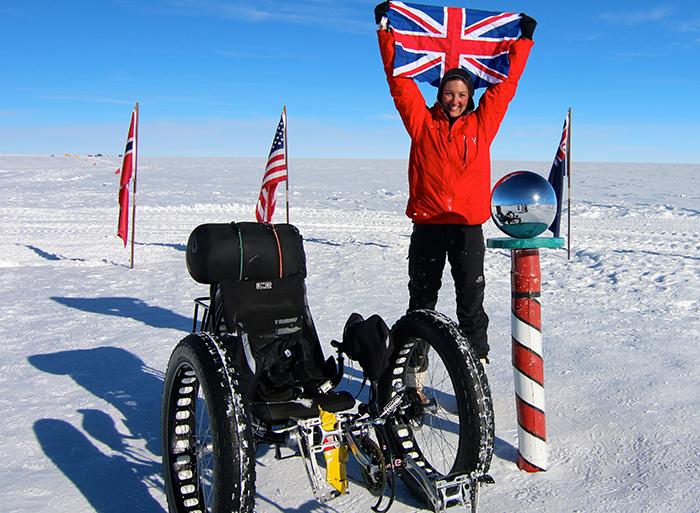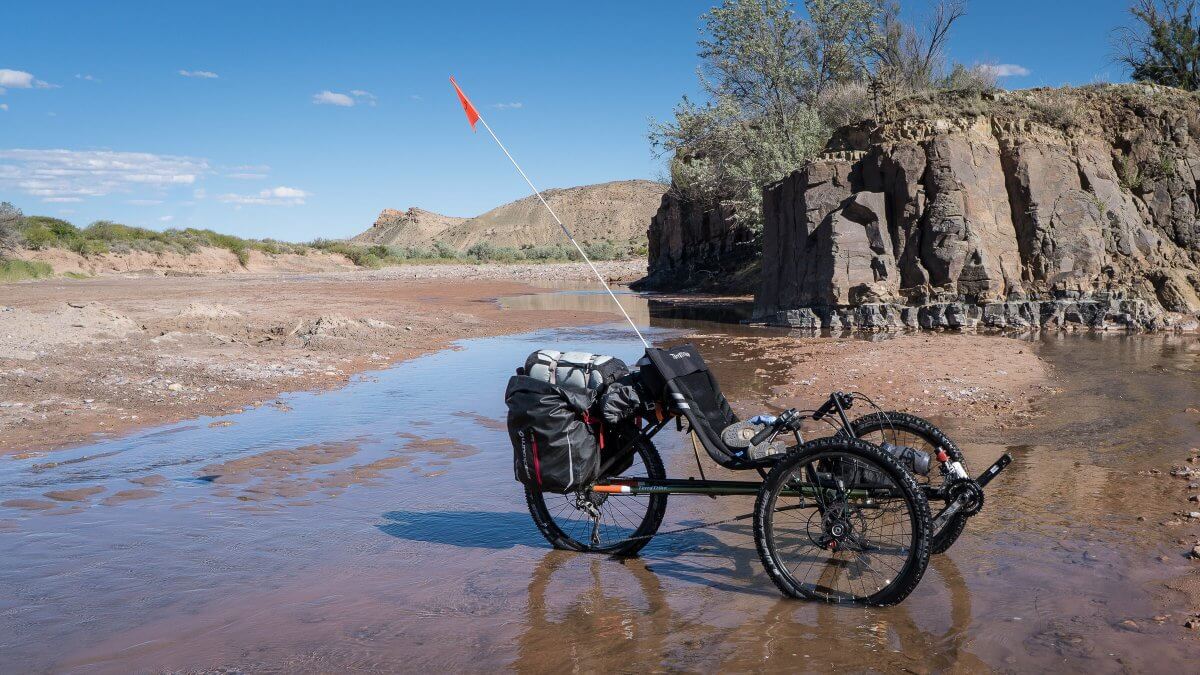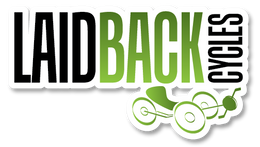Blogs

April 02, 2020
A Winning Success Story And The Ride To Recovery.
(Reprinted from ICE website)
Wesley’s story is amazing, not only did ride 12,606.3km last year on his ICE VTX trike, which made him the winner in ICE’s total distance ICE Strava Club challenge, he did this after unfortunately suffering a stroke in February 2014.
He and his wife were in Taipei Taiwan for Wes’s wife’s sabbatical from teaching at NM Tech, he had recently retired from the National Radio Astronomy Observatory when he had a stroke. After two brain surgeries and spending the remainder of her sabbatical in a Taiwanese hospital. He failed his driving exam in November 2014 (passing the second examination in April 2016). He initially rode another brand of trike, which he used in 2015 and 2016 putting about 9000 miles on it. Late in 2016 he acquired an ICE VTX. He set personal goals of 6000 miles which he exceeded by over 1800 miles!
The real beauty of a recumbent trike is that it gives a real opportunity to continue cycling and improve your health and mobility, especially if riding a regular bike is not possible.
Wesley kindly sent ICE his story and some great photos from 2107. It’s with a lot of hard work he has gone from wheelchair, to walker, to cane, to walking unaided. He says, “I still have some wobbly moments but that’s to be expected. I won’t ride a upright again, it’s just to dangerous for me but the VTX gives me a lot a freedom at 12mph.”
This is Wesley about three years after his stoke, trying to master rollers in physical therapy, achieving thirty to forty seconds without banging into the parallel bars, short of his two minute goal. Here are some photo’s Wesley kindly sent.
Thank you for your inspiring story Wesley and good luck on your continued ride to recovery.

March 27, 2020
Triking To The South Pole
Over Christmas 2013 a British woman attempted to become the first person to cycle to the South Pole.
Racing over 400 miles from the edge of the Antarctic continent Maria Lijerstam hoped to beat two other male contenders to claim the world record.
Maria, aged 35, faced savage conditions with temperatures as low as -35°C and wind speeds up to 50 miles per hour. She had to overcome dangerous obstacles such as crevasses, shifting ice shelves, glaciers and snowstorms.
This audacious challenge had been attempted before by riders on standard winter bikes known as Fat Bikes, but none had succeeded. After two years research Maria has took a radical new approach that hopefully would help win her the title and re-define the future of polar expeditions.
“Fat Bikes fail because they get blown over in the high winds, or can’t ride fast enough through the snow to stay upright. I knew I needed something that would overcome these limitations.” said Maria, who runs Multisports Wales.
Maria rode an extraordinary polar trike designed specifically for the challenge by the aptly named ICE Trikes, based in Falmouth, UK.
The custom-made machine was a recumbent trike, which is stable and aerodynamic. Riding in the recumbent position Maria could focus her energy on progressing through the gale-force winds and hazardous terrain.
“The trike is amazing. It’s completely stable, even in extreme winds and I can take on long steep hills that I’d never be able to climb on a bike” said Maria.
The design was based on a standard ICE Sprint recumbent trike, with modifications to ensure it could tackle the rigorous challenge ahead. The frame was made from an aircraft grade steel selected for it’s strength and fatigue resistance. It was fitted with 4.5 inch wide snow tyres for unsurpassed traction and float over snow and ice. The gears where effectively twice as easy as a standard mountain bike, which allowed Maria to climb 1-in-3 gradients.
“This is a beast of a trike. It’s very special and there’s nothing else like it in the world. Our standard trikes are highly sophisticated and they retail from £2000. Maria’s trike would cost in the region of £20,000″ said Chris Parker, director of ICE Trikes and designer of Maria’s polar trike.
Maria’s preparation included training and equipment testing in Siberia, Norway and Iceland. To replicate the severe cold of Antarctica she endured a day cycling in an industrial freezer — much to the surprise of factory workers who continued to stack shelves with frozen food.
Maria identified a route to the South Pole virtually untested by polar explorers. She started her bid for the world record by climbing the Leverett Glacier before heading due south for the South Pole some 400 miles ahead. The route she would take was used by American scientists based at the McMurdo Research Station on the Ross Ice Shelf to transport fuel to the South Pole.
The radical approach of using a recumbent trike on a new route would re-define the future of polar expeditions. Maria predicted that extreme tourism companies would offer trike expeditions in the near future.
“In a few years’ time companies who now run polar ski tours will also offer polar trike tours” said Maria.
As manager of a company that organises adventure races and training, Maria knows the industry well. She is accustomed to extreme sports and in 2012 came second in the Black Ice Race — a 400 mile winter cycle along the entire length of Lake Baikal in Siberia.
Maria was truly prepared to take on the challenge ahead.
“I have met Maria, seen the polar cycle and spent time with her on her training trip in Iceland. I am convinced she has a very good chance of making it” said Emil Grimmsson, CEO of Arctic Trucks who will support Maria during her world record attempt.
Watch the preview of the documentary on itv.com or read her book on Amazon.com

March 19, 2020
My New Love Affair With Three-Wheeled Bikes
Outside Magazine writer Jen Judge rode a Rambler AT several hundred miles #trikepacking the backroads of New Mexico.
I’ve ridden and loved bikes for 35 years, raced since I was ten, and idolized the greats like Greg Lemond, Bernard Hinault, and Andy Hampston. Cycling is in my blood, and to me it always meant two wheels—until now.
Sixteen months ago, I broke my arm. Everyone said it was a minor break, but the injury festered. The pain worsened, and doctors shook their heads. And then, almost a year to the day, I rebroke it trail running. I started going crazy: I couldn’t ride a regular bike, nor I could I run, do yoga, hunt, or fly-fish.
Then one day, in a moment of frustration, I started looking for recumbent, three-wheeled bikes that could handle dirt. For “serious” cyclists, a recumbent, or trike, is about as appealing as training wheels. I’d never considered riding one, but soon found the Terra Trike Rambler All-Terrain, a brand-new design that landed on my doorstep a few weeks later. And though I hadn’t ridden it yet, and though I’d been couch-bound, and though I had only a week until I left for a photography assignment in Jordan, I concocted a trikepacking tour of the backroads of New Mexico.
Four days, three nights, and several hundred miles later, I was sold. The Rambler takes all the good parts about cycling and leaves out the bad. (More on that below.) Just off the couch and on a two-wheel bike, I would never have been able to log as much time as I did and see so much country. The Rambler, however, gave me the freedom to get out and enjoy what I love. Which is why, though I’ll never completely divorce my bicycle, I foresee a lasting affair with the trike.
Read the entire article here.

March 15, 2020
Tackling The COVID-19 Outbreak With Trikes!
Even doing just a few minutes of exercise every day can improve brain function, reverse the effects of aging in the heart, and may even improve your memory. Exercise can also be a boon to mental health. But in the midst of the coronavirus pandemic, you may not want to hit the crowded gym?
How To Exercise Safely
Exercising outside or in your home allows for social distancing, and you can still get your fit fix for the day. Experts suggest that folks try running or cycling outside, rather than take an organized class inside a studio.
At Laid Back Cycles we provide multiple ways to exercise while keeping your safe social distance and still have fun. You can join one of our local rides, we can ship a trike anywhere in the nation if you don’t want to go out in public, or we can ship you a trike training to do your workout in your home.
Our advice to stay fit and healthy is to get outdoors where you have great ventilation and a nice cross breeze.
It is up to you to decide whether you want to get out of the house at all, but the benefits of exercise are undeniable.
Cycling on a stable, easy to ride recumbent trike or some form of exercise is good because it boosts your immune system, plus it is a good instinct to want to continue working out.
The new MagTrainer from SportCrafters is the best way to train indoors. It is quieter than any traditional fan resistance trainer on the market. As the drum spins about the magnets built in to the rear roller, they create resistance through eddy currents. This provides just the right amount of resistance for training indoors while reading a good book or watching your favorite TV show!
FREE SHIPPING on trikes* (Extended till March 31st, 2020)
Want to save over $300 on your trike purchase? We are waiving the shipping cost, regularly $299 and up, on our most popular trikes to anywhere in the lower 48 states for our March Madness Sale.
Our professional trike fitters will help set your trike up so that when it arrives fully assembled at your door, it is ready to ride in comfort and with ease.

February 27, 2020
How To Ride A Recumbent Trike
We like to say there is no such thing as a silly question. But there are some that may seem a little awkward to ask. You know, the basic things that seasoned riders assume everyone knows about riding a recumbent trike. Well, below we hope to answer many of those questions before you even have to ask them. If you do have any further questions, feel free to contact us. The only silly question is the one that goes unasked.
Here are the basics on how to, and, in some cases, how NOT to ride a recumbent trike.
GETTING INTO A TRIKE
Simply getting in and out of a recumbent trike can be a little intimidating if you’ve never done it before. However, it doesn’t have to be if you follow these few easy steps. First of all, always make sure your trike’s brakes are locked to prevent it from rolling when you are entering or exiting it.
Begin by straddling the “boom” of the trike. The boom is the front tube extending in front of the trike and attached to it are the crankset and pedals. Approach the trike from either side in front of one of the front wheels and step over the boom with one foot with your back facing the front of the seat. Then move back toward the seat until you are in a position to lower yourself into it. Use the wheels and/or the edge of the seat frame as aids to guide and support you and ease yourself down onto the seat. It is a good idea not to “plop” yourself down into the seat as that can introduce very high instantaneous loads onto the seat frame, which can lead to premature seat frame failure. NEVER use the handlebars on linkage steering trikes to support your body weight (see more info on “Steering a Trike” below) as they are not load bearing members of the trike and can be damaged with the stress of trying to support you. You may, however, use the handlebars on all direct steer models (trikes with one tie rod) as supports. We also offer optional Bars which bolt onto the trike handlebars to aid in ingress and egress. To exit the trike lock the brake(s) and reverse the process.
PEDALING A TRIKE
We recommend that every trike be equipped with some sort of foot restraint to make sure that each of your rides is safe and trouble free. Clipless pedals, PowerGrip pedals or our heel strap pedals are great ways of keeping your feet securely on the pedals. Failure to keep your feet securely on the pedals, which could be caused by a bump, pothole, driveway/sidewalk/street crossing, etc. on your route, could result in your foot slipping off of the pedal(s) and getting caught between the trike and the ground. This could ruin an otherwise great ride and can sometimes cause moderate to severe injury.
The other advantage to attaching your feet directly to the pedals is that it allows you to get more power out of each pedal stroke. Not only do you get the push on the forward stroke, but you get the pull on the back stroke (if you so desire). This results in a more even cadence and less effort to propel your trike. Also, because you do not have to worry about tipping over when you come to a stop (as on an upright bike), you can simply stay clipped or strapped into the pedals when you stop.
Always use the appropriate gear for the speed and effort you’re exerting. Using too low of a gear can result in what is known as “spinning out” of a gear where you are pedaling faster than is comfortable for you. This comfortable cadence (“cadence” is how fast you are spinning your pedals and it is measured in RPMs of one pedal’s full rotation) varies from person to person as some people like to spin their pedals faster and some like a more leisurely pedaling speed. Shift to a higher gear to reduce your pedal speed. Conversely, climbing hills or starting off from a stop in too high of a gear can be difficult and can also be damaging to the trike’s drive train. Always try to use a lower gear when starting from a stop or climbing hills. To do this you need to learn to anticipate when to downshift as you climb hills and/or come to a stop so that you are in the appropriate gear for a given grade.
STEERING A TRIKE
Trikes generally come with one of two different steering mechanisms: Direct steering or Linkage steering. Not many models feature Linkage steering but it is easy to recognize because it utilizes two tie rods instead of just one. Linkage steering is sometimes described as a sort of “power steering” because of the mechanical advantage you gain with the longer lever arm of the handlebar and the center pivot of the steering assembly on these trikes. Linkage steering uses two tie rods to “link” the two wheels to a center pivot to which the handlebar is attached. Because it is somewhat easier to steer, a rider can easily control the trike with a single hand.
Most models feature a Direct steering mechanism. In this configuration, the handlebars are attached directly to the steer tubes of the hubmounts (similar to the way bicycle handlebars are attached to front forks) and the wheels are connected to each other with a single tie rod for a sportier, more responsive feel to steering inputs. People liken this type of steering to more of a sports-car type of handling because steering is more responsive to rider input.
Both types of steering take a little time to get used to and you will, in short order, begin to understand how your trike responds to your steering inputs. When taking corners, it is recommended that you lean into the inside of the corner and not use one brake lever but rather both, simultaneously. Failure to lean in, especially at higher speeds, can result in lifting a wheel or, in the worst case scenario, losing control and potentially rolling the trike.
Always learn the dynamics of your trike at slow speeds to get the feel of it before riding at higher speeds. Sudden steering inputs will result in unpredictable handling and can result in a loss of control and possibly a crash. Be careful!
CHANGING GEARS
Depending upon which model you choose, your trike will come with a variety of gearing options. However, we really only offer two different types: Internally geared hubs and traditional derailleur-type systems.
Internally geared hubs (IGH) are maintenance free, easy to use options. Changing the gears is as simple as just twisting the gear shifter on the handlebar and continuing on your way. There is no need to even know what gear you are in. Just shift up or down to maintain a comfortable pedal speed. Internally geared hubs require a little bit of a “pause” in your pedaling before the gear can engage. So, when changing gears with an IGH, just stop pedaling for a moment, shift and, when you resume pedaling, you will feel that the gear has changed. A nice advantage of this type of drive train is when you come to a stop after being in a higher gear and have forgotten to downshift. All you have to do is shift to a lower gear and you will start off in that newly selected gear. Elegant simplicity.
The traditional derailleur-type system (externally geared drive train) is what most people are familiar with. These have a cluster of several different sized cogs on the rear wheel with a shifter to control them and anywhere from one to three gears on the front crankset with its own shifter if so equipped. This type of drive train generally has a wider range of gears to choose from when compared to an IGH. With derailleur systems, a common issue among new riders is something called “cross-chaining”. This occurs when the smallest rear cog and smallest chainring up front or the largest rear cog and the biggest chainring up front are selected at the same time. This causes too much slack or too much tension in the chain and can reduce the lifespan of your components, cause your chain to derail or, in extreme cases, rip the rear derailleur off of your frame. And no one wants THAT to happen! So please don’t cross-chain. Your trike will thank you.
There are a few key highlights to proper shifting techniques with derailleur systems. The main hurdle is timing. Most people wait too long before shifting into an easier gear. Especially when climbing a hill, it is necessary to shift before you think you need the lower gear. If you wait until you can no longer push the harder gear then the load on the chain will be too high to allow it disengage from the gear it is in. To allow the chain to move easily from gear to gear it is sometimes necessary to reduce the load on the chain. This is achieved by backing off the pedal pressure (soft pedaling) so that you can engage a lower gear. At this moment the chain has less load on it and will shift smoothly. But you MUST keep pedaling while shifting with this type of drive train.
TRANSPORTING A TRIKE
Transporting a trike or trikes is not a difficult as one imagines. First of all, always use a method that is recommended for recumbent trikes. There are several different bike carriers out there, but they often do not support a trike properly and securely. You can get advice from the place where you purchased your trike.
Other models fold and can be easily transported in most vehicles. Minivans, SUVs and many hatchbacks can transport trikes without any disassembly; although seat removal sometimes facilitates matters.
The other option is to use a hitch rack or roof rack. There are many options available on the market that allow for easy loading and unloading and secure transport without sacrificing any space inside your vehicle. We always recommend that you take off the seat when doing this as the wind can damage the seat over long drives and it will also reduce you gas mileage.

February 26, 2020
Are Recumbent Trikes Comfortable?
The short answer is Yes!
It’s usually the main reason people gravitate to recumbent trikes and the reason why they are the fastest growing segment of the bicycle industry.
Recumbent trikes are comfortable, easy to ride, and fun! You ride in a semi-laid-back position, with your legs in front of you in a relaxed state. Your body’s weight is distributed over a wider area so that there is not allot of pressure on any one point of the body. Riding a trike reduces wear-and-tear on the body and fatigue compared to a conventional bicycle.
A recumbent trike provides a good workout for individuals of all ability levels. It is safe and provides a low impact total body workout. Due to the low impact the recumbent trike reduces the risk of pain and can build strength. On a trike you can get a low-impact aerobic workout. You can burn lots of calories depending on how long or intensely you ride; or you can go at a comfortable pace and just get a good workout.
No pain in the butt
Comfortable on the back, legs and wrists
Easy to get in and out of
Ease and comfort means you ride longer and farther
Still get a great workout
Dont need to worry about balancing
Hundreds of accessories to gain even further comfort
Several great manufacturers: ICE, Catrike, Greenspeed and TerraTrike

February 23, 2020
TerraTrike Storage Solution Bags
TerraTrike, makers of the world’s most comfortable recumbent trikes, announced the expansion of its popular Storage Solutions Collection with seven new bags. Building on the adventure capability of the popular TerraTrike line, there are now 14 unique bags in the TerraTrike Storage Solutions Collection.
“It’s not enough to just get around in comfort on a TerraTrike these days, customers are demanding adventure-ready gear – from a simple jaunt down to the store to a sojourn across the desert of New Mexico,” said Jeff Yonker, marketing director at TerraTrike.
Whether commuting, exercising or touring, the new additions to the Storage Solutions Collection protect gear from water, dirt, road grime and wind damage. Made with durable polyester and nylon, most of the new bags are custom-fitted to late model TerraTrikes. Many will also fit other recumbent trike brands.
“People are getting further and further off the beaten path and going on longer and longer rides with our trikes,” said Yonker. “The Storage Solutions Collection was built to make sure they can carry everything they need. We love seeing how far out customers go and, of course, hearing them rave about how capable trikes are.”
The seven additions to the Storage Solutions Collection include:
Versa Bag ($29.95 MSRP) – Designed to attach to the popular VersaBars accessory (sold separately), this compact bag is great for a cell phone, wallet, camera, keys or map. When used with the VersaBars, it is easily accessible while riding and the clear vinyl pocket is perfect for map viewing on the move. Easily attached and removed with two Velcro straps. Sold individually, they can be mounted on either or both sides of the trike.
Easy Reach Bag ($24.95 MSRP) – A simple, durable bag to carry the items most riders have in their pockets. Large enough to carry a phone, keys, wallet, camera or trail snack. Velcro straps allows it to be mounted just about anywhere. The two interior pockets are gusseted to keep objects in place when opened.
Deluxe Seat Bag ($54.95 MSRP) – A more refined version of our original seat bag, it features two clips and a bottom strap to securely mount it on the back of a rider’s seat. The full-width zipper allows easy access and the top flap opens so items won’t fall out. Plenty of space for a cell phone, wallet, keys, camera, tools, a pump and a small lunch.
Commuter Pannier ($99.95 MSRP) – Designed with an integrated rain-fly and plenty of pockets and space, this bag will safely and conveniently transport a tablet or small laptop, important papers or text books. Make it a mobile briefcase or simply extra storage for any adventure by removed the detachable tablet sleeve.
Expedition Pannier ($119.95 MSRP) – The largest bag in the Storage Solutions collection, it’s perfect for trikepacking or just carrying a lot of groceries. The two zippered extension pockets on the end expand the overall length of the bag and can easily fit a tent, short camping chair or folded fishing pole.
Stowaway Bag ($119.95 MSRP) – The Stowaway Bag is the most unique bag in the Storage Solutions family. This “U” shaped bag fits neatly behind the seat, wraps around the rear wheel where it helps lower the trike’s center of gravity. The zippered ends allow for easy access from either side, and the Velcro interior partitions allow customization of the space.
Low Rider Rack – Designed to sit behind and under the seat, it allows for attachment of low profile panniers, such as the Commuter Pannier or Expedition Pannier and is also the perfect mounting point for electric assist batteries, helping to keep the trike’s center of gravity low.
Requires the addition of the appropriate Low Rider Rack Fit Kit (sold separately, $12.95 MSRP). Available for Rambler, Rover and Sportster models.
The original Storage Solutions Collection includes: Adventure Pannier (two durable saddle bags), Shopping Bag (perfect for that Sunday grocery store run), Trunk Pack (a handy, durable bag that attaches to the top of a Rear Rack), Deluxe Trunk Pack (an expandable version of the Trunk pack with a custom mounting plate for quick detachment), Cargo Rack (sits above the rear wheel and allows for attachment of panniers and a trunk pack), Seat Bag (a compact bag for pocket items), and Bottle Pocket (a padded sleeve for a water bottle that easily attached with Velcro).

November 22, 2019
2019 Holiday Sale
From now until the end of the year, we’re having a Holiday sale.Now is the chance for you to get some great deals.
Hurry before time runs out!
Catrike
Get $200 of Catrikes in Limited Edition Elements Colors
Sky Blue
Fire Red
Storm Grey
Hyper Yellow
Includes all models except the Eola.
See Available Models
TerraTrike Gran Tourismo and EVO
TerraTrikes with e-assist transform the way you ride. It will also enhance your range by degrees of magnitude. Now, you can easily climb hills which were a daunting task previously. The lightweight Bosch mid-drive unit is strategically placed and the battery is frame mounted making the trike so well balanced you’ll forget it’s even there.
Choose the EVO or add the TerraTrike boost Kit to any Gran Tourismo and get FREE SHIPPING!
See Available EVO ModelsSee Available Gran Tourismo Models
SportsCrafters Roller Trainer
The new MagTrainer from SportCrafters is the best way to train indoors. It is quieter than any traditional fan resistance trainer on the market. As the drum spins about the magnets built in to the rear roller, they create resistance through eddy currents. This provides just the right amount of resistance for training indoors while reading a good book or watching your favorite TV show!
Get $20 off!
More Information
November 14, 2019
NEW! TerraTrike Padded Seat Cushion
The new TerraTrike seat cushion pretty awesome, it is super comfy and can go on pretty much any Terratrike you have. They can go on your Rambler, All-Terrain, Traveler, Gran Tourismo, Sportster and they even make a wider one which goes on the Rovers that have a wide seat.
The Seat Pad is a thick cover that adds comfort and cushioning to your existing TerraTrike seat. The Seat Pad covers the entire seat. It slips over the top and bottom ends of the seat, and secures in place with a wide Velcro strap that gives you a nice form-fitted seat cover to your seat.
• The Seat Pad provides a thick soft cushion for your existing TerraTrike seat• Easy to install, the Seat Pad slips over the ends of the seat and secures with a Velcro strap• Size: 1.5″ thick, 17.5″ wide, 31″ length• The black breathable mesh wicks moisture• The open cell foam core sections can be removed and the seat cleaned, if needed• Black mesh, embroidered in two colors with the TerraTrike “TT” icon
On the back you have holes for your flag so your flag still can go in. You also have extra holes in the top so if you have the deluxe seat bag it will fit perfectly.
It comes in a nice little box that we can ship to you anywhere across the country. Order here.
If you live near our shop feel free to drop by and pick one up at Laid Back Cycles. The new seat pad is pretty awesome. Check it out if you want extra comfort on your tushie, back or spine.
If you have a wide seat Rover Order Here

